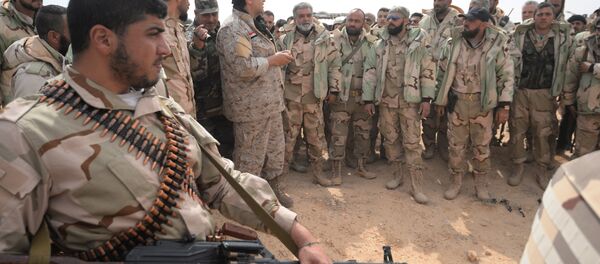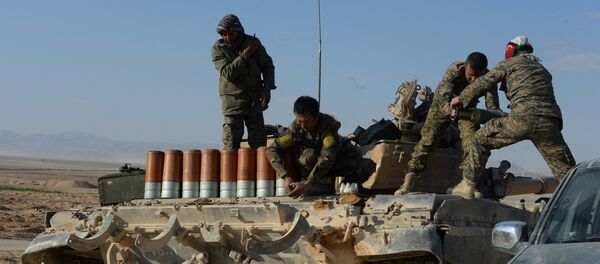Fierce clashes broke out between the Syrian Army and Daesh militants in the south-western part of the city where Palmyra’s hotel complexes are located.
RIA Novosti correspondent Mikhail Alaeddin witnessed militia forces storming the Semiramis hotel and making their way to the city once dubbed the "Bride of the Desert."
Early in the morning, a motorcade of technical, ambulances and personnel-carrying trucks drove toward Palmyra. This was the Desert Falcons militia led by Commander Mohammed Jaber.
Вот вам первое фото исторической части Пальмиры от группы Поддубного. Продолжаем следить за наступлением. #Palmyra pic.twitter.com/OiFWx1QQvg
— Evgeny Poddubnyy (@epoddubny) 24 марта 2016 г.
The first photo of the historic area of Palmyra from Rossiya 24 correspondent Evgeny Poddubniy.
The Desert Falcons ("Suqur al-Sahra" in Arabic) were formed in the early days of the Syrian civil war by retired Col. Mohammad Jaber. They are estimated to include up to 5,000 volunteers fighting alongside the Syrian Army. Jaber Sr. was in charge of funding the forces. They coordinate their actions with Syrian Army command and are not supported by any country or sponsor from abroad. The militia comprises of people of various faiths.
Соколы пустыни продолжают теснить ИГ в Пальмире. Темп продвижения снизился, но подходят резервы pic.twitter.com/sCdpAbSAmd
— Evgeny Poddubnyy (@epoddubny) 24 марта 2016 г.
The Desert Falcons continue their attack on Daesh militants near Palmyra. Photo by Rossiya 24 correspondent Evgeny Poddubniy.
"We received an order from the Syrian Army command to deploy our forces for an assault on Palmyra. We are warriors and we are determined to win. If it’s God’s will we will meet in Palmyra in a few days," Jaber said.
Everyone fighting for Palmyra understands that the city is not only of historic importance. Hidden by a high chain of mountains, the small city could be a jumping board for the army’s assault on Raqqa, the so-called capital of Daesh, and the besieged city of Deir ez-Zor.
Бои в Пальмире продолжаются Две роты пытаются закрепиться на отбитых у боевиков игил позициях Вот вам Пальмира pic.twitter.com/P0ybmaQmBf
— Evgeny Poddubnyy (@epoddubny) 24 марта 2016 г.
The battle of Palmyra goes on. A view of the city. Photo by Rossiya 24 correspondent Evgeny Poddubniy.
The offensive on Palmyra has already taken two weeks and when the Falcons began strengthening their positions at the Haya ridge. It was first reported that militia forces had managed to cut off terrorists’ supplies line from Al Quaryatayn, on the Damascus-Palmyra highway.
Col. Jaber later arrived to the frontline to cheer up the fighters and to command the assault. Vanguard units went into the assault on the heights separating them from Palmyra. The fighting was tooth and nail.
"From now, the attack will speed up. The crossroads and the heights are very important. Now we’ll clear the city of enemy forces. I’ll send troops to strengthen our positions," Jaber enthusiastically said.
Unfortunately, the first fighter was killed by a landmine. It was found out that terrorists had mined the road from the Palmyra crossroads. Discovering this, the offensive was suspended. Bomb specialists spent several hours to clear mines.
On the next day, militia forces prepared for an attack on Palmyra. Artillery was deployed near the liberated heights, and tanks and armored vehicles were put to the right and left flanks.
Semiramis is the largest hotel complex in Palmyra. The attack was lightning-fast. Militia fighters rushed to the hotel while artillery fire rained down from the heights. The fighters dispersed and took the hotel buildings. Shortly after, the report came that Semiramis was liberated.
A few hours later it was clear the entire hotel complex was clear. According to officers, in the coming days Palmyra would be "returned to the Syrian people," and its historic legacy – to the world. It will soon be clear whether the ancient city lies in ruins or would it continue to impress tourists with its treasures when the war ends.






